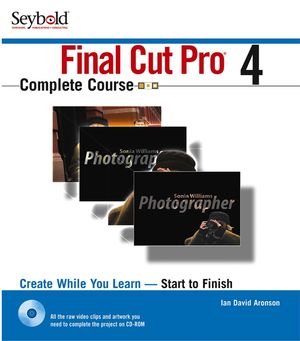Final Cut Pro®4 Complete CourseISBN: 978-0-7645-2591-9
Paperback
368 pages
December 2003
 This title is out-of-print and not currently available for purchase from this site.
|
Confidence Builder.
Building the Basic Project.
Creating Titles to Go with Your Audio.
Adding Fades and Transition Effects.
Rendering and Exporting: The Final Steps.
Part I Course Setup.
Final Cut Pro 4 Basics.
Check the System Software.
Update the System Software.
Project Overview.
General Work Tips and Computer Instructions.
Part II: Getting Started.
Session 1: Starting the Project.
Changing Settings and Editing Presets.
Opening a New Project.
The Importance of Organization and File Management.
Logging and Capturing Digital Video.
Importing Digital Video.
Organizing the Project Contents into Clips and Bins.
Session Review.
Session 2: Assembling a Project.
Planning Your Structure Before You Cut.
Working with the Bro wser, the Viewer, and Clips.
Using Markers and In and Out Points.
Working with the Timeline Window.
Placing Clips in the Timeline.
Adjusting Clips in the Timeline.
What Is a Sequence, and How Do You Build a Good One?
Session Review.
Part III: Basic Editing.
Session 3: Working with Clips.
Using File Management Strategies.
Making Subclips.
Adding a Named Marker.
Extending a Marker to a Specific Duration.
Turning a Marker into a Subclip.
Adding Video Tracks to the Timeline.
Adding Audio Tracks to the Timeline.
Session Review.
Session 4: Editing Clips.
How Editing Determines the Feel of Your Project.
Managing Destination Controls and Locking Tracks.
Using the Edit Buttons Instead of Dragging Clips.
Using an Insert Edit.
Using an Overwrite Edit.
Using a Replace Edit.
Using a Fit to Fill Edit.
Performing Three-Point Edits.
Refining Your Edits.
Session Review.
Session 5: Transitions, Filters, and Effects.
Straight Cuts or Snazzy Effects: Choosing a Visual Style and Sticking to It.
Adding Transition Effects to Video.
Adding Transition Effects to Audio.
Editing and Tweaking Transitions Until You’re Satisfied.
Creating and Exporting Stills from Video Clips.
Understanding Real Time, Rendering, and the Difference.
Session Review.
Part IV: Working with Audio.
Session 6: Preparing Audio Files.
Creating a Rich Sound Design.
Understanding Digital Audio.
Using Analog Audio in a Digital Environment.
Preparing Audio Files to Replace Problem Sound.
Separating Audio from Video.
Editing Audio: Dialog.
Editing Audio: Environmental Sound.
Adjusting Ambient Sound and Room Tone.
Session Review.
Session 7: Editing Audio Clips.
Adjusting the Volume of an Entire Clip.
Keyframes, Timelines, and the Ability to Precisely Control Your Project.
Setting Different Volume Levels Within a Clip.
Working with Audio Effects.
Using the Audio Mixer to Set the Levels of an Entire Clip at Once.
Using the Audio Mixer to Create Complex Volume Control Effects.
Knowing When to Add Sound and When to Let Your Film “Breathe”.
Fine-Tuning the Audio Tracks at the Subframe Level.
Using the Vocal DeEsser Audio Filter.
Why Film Must Sound Better than Real Life.
Session Review.
Part V: Creating and Animating Titles.
Session 8: Working with Titles.
Maintaining Your Visual Style.
Building the Main Title: Images.
Building the Main Title: Sound Effects.
Using LiveType: Creating Text.
Using LiveType: Adding Effects.
Using LiveType: Rendering and Adding the Title to Your Project.
Session Review.
Session 9: Creating Animated Credits.
Making Sure Your Work Is Title Safe.
Creating a Scrolling Title.
Adding Scrolling Credits to the Timeline.
Creating Crawling Text.
Adding Crawling Text to the Timeline.
The “Kid with a New Toy” Syndrome—Don’t Overdo It.
Session Review.
Part VI: Adding Transparency and Video Effects.
Session 10: Using Transparency, Compositing, and Video Effects.
Understanding Layers, Alpha Channels, Cropping, and Opacity.
Completing the End Credits.
Scaling a Clip to Create a Picture-in-Picture Sequence.
Adjusting the Picture-in-Picture Opacity.
Cropping the ECU Sequence to Create a Split Screen.
Combining Crop, Scale, and Flop Effects to Finish the ECU Sequence.
Session Review.
Session 11: Using Advanced Compositing Effects and Color Correction.
Compositing a Travel Matte.
Fine-tuning the Travel Matte and Adding a Cube Spin Transition.
Understanding Legal, Broadcast-Safe Levels and Color Correction.
Appreciating the Value of a Good Colorist.
Using the Range Check Overlay and Broadcast Safe Filter.
Session Review.
Part VII: Final Edits and Exporting.
Session 12: Putting It All Together.
Creating a Constant-Speed Time Effect.
Creating a Variable-Speed Time Effect.
Creating an Archive Version.
Combining Clips and Sequences into a Finished Project, Part I.
Combining Clips and Sequences into a Finished Project, Part II.
Adding Music and Saving a New Version.
A Film Is Never Finished; You Just Stop Working on It.
Session Review.
Other Projects.
Session 13: Deciding on Your Method of Delivery.
Distributing by Tape, Web, or DVD, and Why It Matters.
Optimizing Your Movie for the Web.
Encoding Your Movie for CD-ROM.
Creating an MPEG-2 for DVD Production.
Submitting a Batch.
Understanding Spatial versus Temporal Compression and Work Arounds for Web Streaming.
Session Review.
Session 14: Exporting Your Movie Project.
The Second Set of Eyes: Showing a Test Audience.
Knowing When to Finish Your Project Yourself and When to Use a Post Production Facility.
Recording from the Timeline.
Using the Print to Video Feature.
Exporting an EDL for an Online Edit.
Exporting OMF Audio Files for a Professional Mix.
Backing Up and Saving Your Files for the Future.
Editing Film in Final Cut Pro and Outputting to a Professional Format.
Session Review.
Appendix: What’s on the CD-ROM.
Index.
End-User License Agreement.



